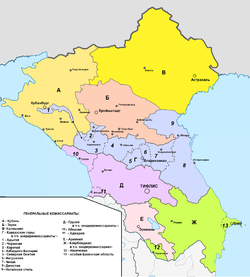Reichskommissariat Kaukasien
This article needs additional citations for verification. (May 2011) |
Reichskommissariat Kaukasien | |
|---|---|
 | |
| Status | Projected Reichskommissariat of Germany |
| Capital | Tiflis |
| Government | Civil administration |
| Reichskommissar | |
• (planned) | Arno Schickedanz |
| Historical era | World War II |
The Reichskommissariat Kaukasien (Russian: Рейхскомиссариат Кавказ, romanized: Reykhskomissariat Kavkaz, German: Reichskommissariat Kaukasien), also spelled Kaukasus, was the theoretical political division and planned civilian occupation regime of Germany in the occupied territories of the Caucasus region during World War II. Unlike the other four planned Reichskommissariats, within the borders of the proposed Caucasus Reichskommissariat experiments were to be conducted for various forms of autonomy for "indigenous groups".[1]
Theoretical planning
Reichskommissariat Kaukasien theoretically included all of
Rosenberg stated that the primary German objective in the region was to attain unlimited access to the oil supplies of Maikop and Groznyi. While Hitler agreed with this assessment, he rejected the proposals for the establishment of a loosely controlled confederacy in the Caucasus.
Rosenberg eventually suggested that the post of the Commissar/Resident should go to his long-time friend and a fellow
Planners theorised about a possible advance to western
Linked to these plans, the German Army planners conceived some operations to project
There was a power struggle between
This planning did not advance much further than preliminary discussions and paper planning, due to the advance of Red Army forces during the war. Historian Norman Rich asserts that the short duration of the German occupation in the Caucasus means that the policies which the Germans implemented give little indication as to the long-term future of the region if it had been brought under firm Axis control.[4]
Turkish involvement
Hitler's strategic thinking delegated
See also
References
- ^ De Cordier (2010), The Fedayeen of the Reich: Muslims, Islam and Collaborationism During World War II, p. 34 China and Eurasia Forum Quarterly, 2010
- ^ (German) Dallin, Alexander (1981). German rule in Russia, 1941-1945: a study of occupation policies, p. 231. Westview Press.
- ^ a b Andrew Andersen and Georg Egge. World War II: Axis Plans for Azerbaijan and the rest of the Caucasus. Retrieved 27 April 2012.
- ^ a b c d Rich (1974), pp. 389-390.
- ^ a b Kroener, Müller & Umbreit (2003) Germany and the Second World War V/II, p. 50
- ^ Kay, Alex J. (2006) Exploitation, Resettlement, Mass Murder: Political and Economic Planning for German Occupation Policy in the Soviet Union, 1940-1941, pages 79, 181. Berghahn Books.
- ^ Kay 2006, p. 181
- ^ Dallin (1981), p. 230
- ^ a b Raymond Arthur Davies and Andrew J. Steiger. Soviet Asia, chapter 5: "Kazakstan: Country with Brilliant Future", pp. 94-119.
- ^ Alexander Werth. The Stalingrad Battle and From Stalingrad to Berlin, chapter 7: "The Caucasus, there and back", pp. 648-668.
- ^ Ivan Tyulenev (1960). Cherez Tri Voyny (Through Three Wars). Moscow, 1960.
- ISBN 978-1-315-40939-9.
- ^ Rich, Norman (1974). Hitler's War Aims vol. II, p. 421
- ISBN 0-19-822884-8.
- ^ Alex J. Kay: Exploitation, Resettlement, Mass Murder: Political and Economic Planning for German Occupation Policy in the Soviet Union, 1940-1941. (Studies on War and Genocide, vol. 10) Berghahn Books, New York, Oxford 2006, p. 72
- ISBN 0-7146-5071-4.
- ^ ISBN 0-7190-5069-3.


